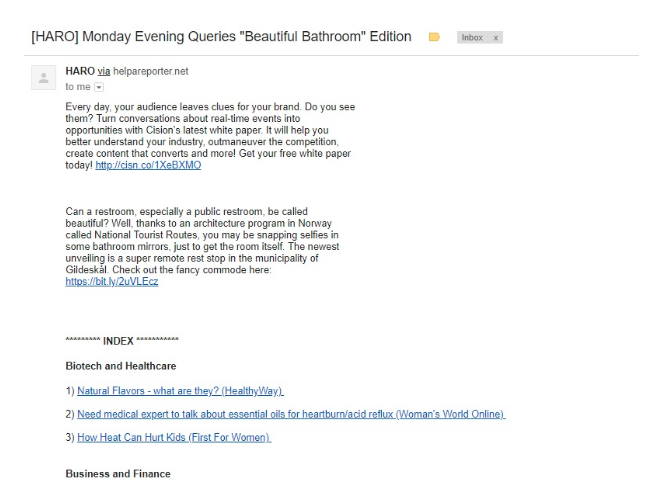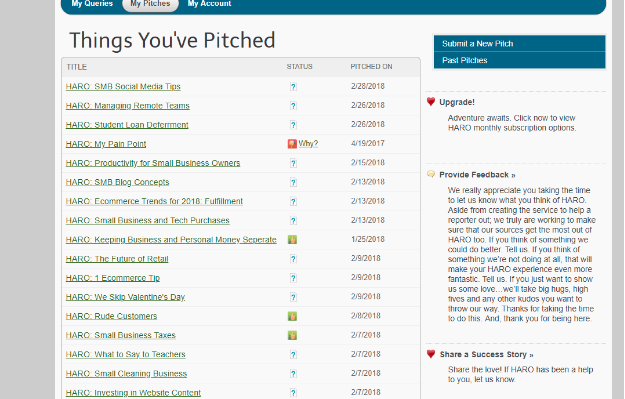My journey to using HARO effectively started because of an observation. Some of my newer competitors that have come onto the scene have venture backing and that comes with significant PR resources. They saw huge jumps in sales immediately at launch, and there were mentioned on the likes of Hubspot, Buzzfeed and Mashable, purely from the PR companies that they had paid with their newly acquired funds.
However, if you’re bootstrapping your startup, paying for a PR company is pretty much not an option, as many PR agencies range in pricing from $2,000 per month up to $20,000 per month.
Too rich for me. So, I went looking for a way to bootstrap PR, and that’s how I found HARO.
Signing up for HARO
If you aren’t familiar with HARO, or Help A Reporter Out, it’s a glorified email list built around journalists (both online and off) looking for sources for stories.
After you sign up on the website, you’ll start receiving something like the below in your email, normally three times a day on regular work days:

A first piece of advice: when you sign up, you’ll be asked which categories you’d like to receive queries about. Take the entire list, as this gives you the chance to respond to a larger number of inquiries. After all, there’s no real downside either, as HARO is free.
Related: The Best Ways to Get Affordable Publicity for Your Side Hustle
Responding to inquiries
As I mentioned, the emails come in three times a day. I’m on Pacific time, so I wake up to one in my mailbox (it comes at 2:30 a.m.) and get another at 9:30 a.m. The final email shows up around 3 p.m.
I bring up the times, because speed matters. There are ending times for queries, but I find that reporters tend to fill their quotable sources pretty quickly.
Part of the reason for this is summed up by Geoff Williams, who uses the service regularly for writing jobs like the Amex Open Forum and US News:
“There are some HARO queries I’ll put out there that will generate, say, 30 or even 60 or 100 (that’s rare) responses – and there’s no way I can use everyone for the article, no matter how brilliant the expert is. But then some HARO queries, I’ll receive maybe five responses, or two. So nobody should ever take it personally, if they respond to a HARO and don’t get a reply back. You probably had a lot of competition.”
When you answer a HARO request, keep in mind what the reporter is specifically looking for.
Joyce Rosenberg, who writes for the Associated Press, added:
“Don’t only say something like, ‘I can talk to you about this.’ Explain why. And stay on point — don’t talk about all the awards you’ve won or how you’re the fastest growing or first or best. Reporters want to know if you can give them the help they need for this story. And, if a reporter is asking for ABC, don’t offer XYZ. For instance, if they want a small business owner who’s had a certain experience, say, someone who tried to keep a customer from leaving, don’t offer them someone who does something only marginally related, or something opposite, like selling software to help you get new customers.”
In general, keep the following response checklist in mind when responding to a HARO request:
- HARO in the subject line, along with something to do with their request (this is important, because some reporters run more than one request at a time)
- A response, which should be as short and to the point as possible
- Include a brief message if you’ve worked with the reporter before or are familiar with the publication. No undue flattery, just an honest moment if it’s warranted
Sign Up: Receive the StartupNation newsletter!
Let’s talk links and SEO
This is one of the hardest aspects to HARO. It can be incredibly frustrating when you spend time to write a response and in some cases, get quoted, but without being credited with a link back to your site. Keep in mind, however, that websites have their own rules and regulations when it comes to link back policies.
“I had one source send me some great information, and I wanted to use some of it in an article and attribute the information to him and would mention his business and so on. He said absolutely – as long as I could link back to his website. Well, this particular publication I wrote for doesn’t link back to websites, I told him. And then he told me I couldn’t use the information he gave me. I thanked him and said I understood, but that entire exchange just felt unsettling to me,” Williams said. “Still, I’d say that 99 percent of my interactions with people on HARO have been extremely positive.”
Helping a reporter finish an article in one instance may directly lead to links in another. Most reporters use HARO consistently, so there’s plenty of opportunities for your startup.
As you respond to more HARO inquiries, you’ll become familiar with the platform’s dashboard to keep track of your work:

Overall, HARO can be an excellent source for legitimate PR mentions for your startup and your brand. As an entrepreneur, it’s easy to focus only on the quantifiable aspects to HARO, and increased links and SEO results are part of the platform. But, there’s a ton of opportunity to build a brand and legitimize your business, as well.
To sum up my advice for startups utilizing HARO: be fast, be concise and remember to help first.






